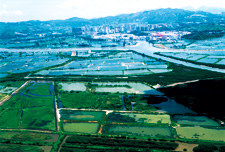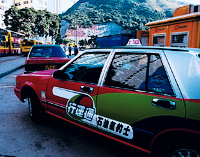- Replacing by 2005 all 18 000 diesel taxis with taxis using cleaner
liquefied petroleum gas (LPG). By April 2002 some 15 000 LPG taxis had
come into service.
- Financial incentives to encourage the introduction of LPG or electric
mini-buses where possible.
- Making ultra-low sulphur diesel the only motor diesel fuel in Hong
Kong - the first economy in Asia to do this.
- Fitting particulate traps on old light diesel vehicles to reduce
particulate emissions by such vehicles by more than 30%.
- Strict emission standards for diesel vehicles. Newly-registered vehicles
required to meet Euro III standards.
- Strengthening emission testing and increasing fixed penalties for
smoky vehicles from HK$450 (US$58) to HK$1 000 (US$128).
These initiatives have already yielded significant results. Air Pollution Index readings exceeding the high level of 100 have been reduced by 45% since 1999 while respirable particulates at roadside stations have dropped by 8% and nitrogen oxides dropped by 11%. The number of smoky vehicles spotted on Hong Kong's roads dropped by half in 2001.
Upon full implementation total particulate emissions are expected to drop by 80%, while nitrogen oxide emissions should drop by 30%.
Considerable efforts are also being devoted to improving water quality and reducing waste through greater recycling and increased public awareness programmes.
Hong Kong can not solve long-term environmental issues on its own. Greater co-operation with neighbouring Guangdong Province is needed to improve the overall environment, particularly in the prosperous Pearl River Delta region.
In April 2002, the Hong Kong SAR Government and the Guangdong Provincial Government agreed on a joint action plan to tackle cross-boundary pollution. This followed a joint study on the problem of deteriorating air quality in the Pearl River Delta, which covers an area of 43 000 square kilometers and has a population approaching 50 million.
The study found that air pollution emissions in the region would continue to increase over the next decade if the two governments continued to implement existing air quality improvement measures.
In light of these results, the two governments agreed that co-operation be increased and additional improvement measures be introduced to deal with the problem of regional air pollution.
Using 1997 as the base year, both governments agreed to reduce, on a best endeavour basis by 2010, regional emissions of sulphur dioxide (by 40%), nitrogen oxides (by 20%), respirable suspended particulates (by 55%) and volatile organic compounds (by 55%).
It was also agreed to draw up a Regional Air Quality Management Plan and assign responsibility for co-ordinating and monitoring the progress of the improvement measures. An expert group involving both sides would be established to jointly monitor trends and changes in regional air quality and evaluate the effectiveness of the ongoing and enhanced improvement measures.
 |
The international business community also voiced concern over deteriorating air quality in 1998 and 1999.
Initiatives taken over the past few years have brought about a noticeable improvement to local air quality.
 |
Measures have included:
|
|
